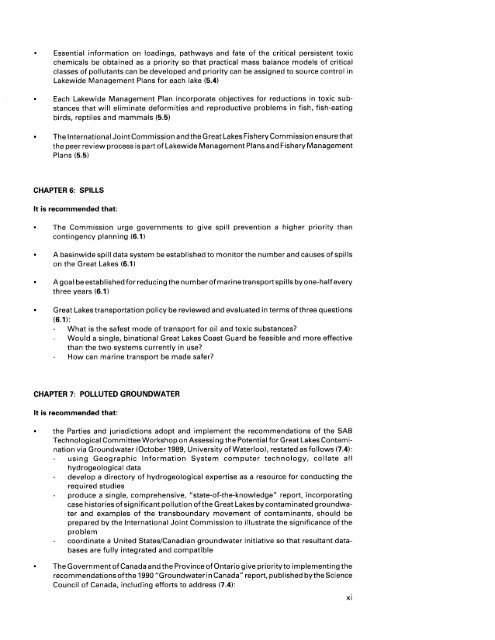International Joint Commission
International Joint Commission
International Joint Commission
You also want an ePaper? Increase the reach of your titles
YUMPU automatically turns print PDFs into web optimized ePapers that Google loves.
Essential information on loadings, pathways and fate of the critical persistent toxic<br />
chemicals be obtained as a priority so that practical mass balance models of critical<br />
classes of pollutants can be developed and priority can be assigned to source control in<br />
Lakewide Management Plans for each lake (5.4)<br />
Each Lakewide Management Plan incorporate objectives for reductions in toxic substances<br />
that will eliminate deformities and reproductive problems in fish, fish-eating<br />
birds, reptiles and mammals (5.5)<br />
The <strong>International</strong> <strong>Joint</strong> <strong>Commission</strong> and the Great Lakes Fishery <strong>Commission</strong> ensure that<br />
the peer review process is part of Lakewide Management Plans and Fishery Management<br />
Plans (5.5)<br />
CHAPTER 6: SPILLS<br />
It is recommended that:<br />
The <strong>Commission</strong> urge governments to give spill prevention a higher priority than<br />
contingency planning (6.1)<br />
A basinwide spill data system be established to monitor the number and causes of spills<br />
on the Great Lakes (6.1)<br />
Agoal beestablishedforreducing thenumberof marinetransportspills by one-halfevery<br />
three years (6.1)<br />
Great Lakes transportation policy be reviewed and evaluated in terms of three questions<br />
(6.1):<br />
- What is the safest mode of transport for oil and toxic substances?<br />
- Would a single, binational Great Lakes Coast Guard be feasible and more effective<br />
than the two systems currently in use?<br />
- How can marine transport be made safer?<br />
CHAPTER 7: POLLUTED GROUNDWATER<br />
It is recommended that:<br />
the Parties and jurisdictions adopt and implement the recommendations of the SAB<br />
Technological Committee Workshop on Assessing the Potential for Great Lakes Contamination<br />
via Groundwater (October 1989, University of Waterloo), restated as follows (7.4):<br />
- using Geographic Information System computer technology, collate all<br />
hydrogeological data<br />
- develop a directory of hydrogeological expertise as a resource for conducting the<br />
required studies<br />
- produce a single, comprehensive, ”state-of-the-knowledge” report, incorporating<br />
case histories of significant pollution of the Great Lakes by contaminated groundwater<br />
and examples of the transboundary movement of contaminants, should be<br />
prepared by the <strong>International</strong> <strong>Joint</strong> <strong>Commission</strong> to illustrate the significance of the<br />
problem<br />
- coordinate a United StatedCanadian groundwater initiative so that resultant databases<br />
are fully integrated and compatible<br />
The Government of Canada and the Province of Ontario give priority to implementing the<br />
recommendationsofthe 1990 “Groundwater in Canada” report, published bythescience<br />
Council of Canada, including efforts to address (7.4):<br />
xi

















